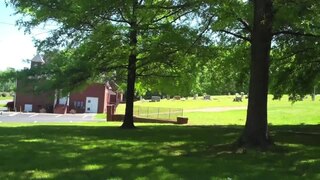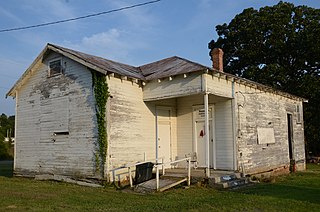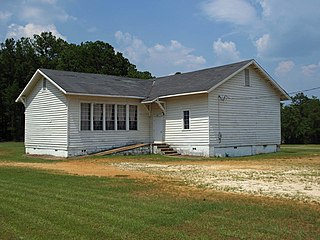
Courtland is an incorporated town in Southampton County, Virginia, United States. It is the county seat of Southampton County.

The Rosenwald School project built more than 5,000 schools, shops, and teacher homes in the United States primarily for the education of African-American children in the South during the early 20th century. The project was the product of the partnership of Julius Rosenwald, a Jewish-American clothier who became part-owner and president of Sears, Roebuck and Company and the African-American leader, educator, and philanthropist Booker T. Washington, who was president of the Tuskegee Institute.

Cairo Rosenwald School is a former school for African-American children located in the unincorporated community of Cairo, Sumner County, Tennessee. It was one of seven Rosenwald schools built in the county.

Durham's Chapel School, also known as Durham's Chapel Rosenwald School, is a former school for African-American children located in Gallatin, Tennessee, that is listed on the National Register of Historic Places.

Freetown Rosenwald School is a historic Rosenwald school building in the historic African American community of Freetown at Glen Burnie, Anne Arundel County, Maryland. It is a simple, one-story, gable-roofed, rectangular frame building. The exterior walls are sheathed in aluminum siding and the gable roof is covered with asphalt shingles and displays minimal overhang. It was built in 1924–25, by the school construction program of the Julius Rosenwald Fund, to serve the local African American community. It is one of ten Rosenwald Schools surviving in Anne Arundel County.

The Emory School, also known as the Tunstall School, is a historic Rosenwald School building in rural Hale County, Alabama, United States. It was built in 1915 to the designs of W.A. Hazel to serve the local African American community. The money to build the school was provided by the Julius Rosenwald Fund. The school was listed on the National Register of Historic Places on February 20, 1998, as a part of The Rosenwald School Building Fund and Associated Buildings Multiple Property Submission.

The Oak Grove School is a historic Rosenwald School building in rural Hale County, Alabama, United States. It was built to the designs of Samuel Smith in 1925 to serve the local African American community. The money to build the school was provided by the Julius Rosenwald Fund. The school was listed on the National Register of Historic Places on March 3, 1998, as a part of The Rosenwald School Building Fund and Associated Buildings Multiple Property Submission.

The Bigelow Rosenwald School, also known as Rosenwald Community Center, is a former Rosenwald School located in Toad Suck, about 10 miles (16 km) northeast of Bigelow, Perry County, Arkansas. Built in 1926, it is a single-story wood-frame building with vernacular Craftsman elements. It served as a school until 1964, when it became a community center. It is the only Rosenwald School building that still stands in Perry County.

Liberty Colored High School is a former high school for African-American students in Liberty, South Carolina during the period of racial segregation. It originally was called Liberty Colored Junior High School. The building is now a community center known as the Rosewood Center. It is at East Main Street and Rosewood Street in Liberty. The school was built in 1937 on the site of a Rosenwald school that had burned down.

The Mount Sinai School is a historic Rosenwald School in rural Autauga County, Alabama, US, northwest of Prattville. The one-story frame building was built in 1919 to the designs of W.A. Hazel to serve the local African American community. The money to build it was provided by the Julius Rosenwald Fund. The school was added to the Alabama Register of Landmarks and Heritage on February 2, 2001. It was subsequently listed on the National Register of Historic Places on November 29, 2001, as a part of The Rosenwald School Building Fund and Associated Buildings Multiple Property Submission.

The Tankersley Rosenwald School, also known as the Tankersley Elementary School, is a historic American Craftsman-style school building in Hope Hull, Alabama, a suburb of Montgomery. This Rosenwald School building was built in 1922 to serve the local African American community. The money to build the school was provided, in part, by the Julius Rosenwald Fund. It was added to the Alabama Register of Landmarks and Heritage on June 26, 2003, and to the National Register of Historic Places as a part of The Rosenwald School Building Fund and Associated Buildings Multiple Property Submission on January 22, 2009.

Queenstown Rosenwald School, also known as Sunnyside School, is a historic Rosenwald school building located at Severn in Anne Arundel County, Maryland, United States. It was built in 1932 and is a plain, one-story, frame building. The building contained two classrooms and a library. The school closed in 1966 and subsequently became the Queenstown Community Center.

The Lula G. Scott Community Center is a historic site located at Shady Side, Maryland in Anne Arundel County, Maryland, United States. It now consists of two frame buildings that were built as Rosenwald Schools.
Deatonville is a rural unincorporated community in the western part of Amelia County in the U.S. state of Virginia. It is located in Leigh District along SR 616 at its junctions with SR 617. Deatonville straddles the boundary between ZIP codes 23083 (Jetersville) and 23966 (Rice). One segment of U.S. Bicycle Route 1 runs southwest from Richmond; this segment follows the entire length of SR 616 through Amelia County and passes through Deatonville.

The First Union School is a historic Rosenwald school building for African-American children located at 1522 Old Mill Rd. in Crozier, Virginia. It was built in 1926, as a two-teacher school. It is a one-story frame school on a concrete foundation. It has an engaged porch and hipped roof. The listing included two contributing buildings. The school operated until December 1958, when the county integrated its public schools. It was converted to residential use in 1985.

The Second Union School is a historic Rosenwald school building for African-American children located near Fife, in western Goochland County, Virginia. It was built in 1918, as a two-teacher school, near Second Union Baptist Church, which had been founded in 1865 as an independent black congregation.

Greensville County Training School, also known as the Greensville County Learning Center, is a historic Rosenwald school building located at Emporia, Virginia. It was built in 1929, and is a single-story, U-shaped brick building. It consists of a front hyphen that connects two wings containing classrooms, while an auditorium, office space, and a library form the interior central space. A classroom addition was constructed in 1934. It was constructed for the education of African-American students, and closed in the 1960s following desegregation of the public schools.

The Marley Neck Rosenwald School is a historic school building located at 7780 Solley Road in Glen Burnie, Maryland. It is a single story wood-frame structure measuring 68 by 20 feet, with a gable roof. The school was built in 1927 with design and funding assistance from the Rosenwald Fund, and served the area's African-American students. Out of the original twenty three built, it is one of the ten surviving Rosenwald schools in the county.

The Buckingham Training School is a historic school property at 245 Camden Street in Dillwyn, Virginia. Now Ellis Acres Memorial Park, the property's centerpiece is a community center that was built in 1932 as the automotive shop building of the local Rosenwald School. The building was one of 11 such facilities built with Rosenwald funds in Virginia, and one of about 160 nationwide. It is a modest single-story wood-frame structure with a concrete block foundation and weatherboard siding. Its interior has retained many original features despite standing vacant and the undergoing rehabilitation for use as a community center.






















